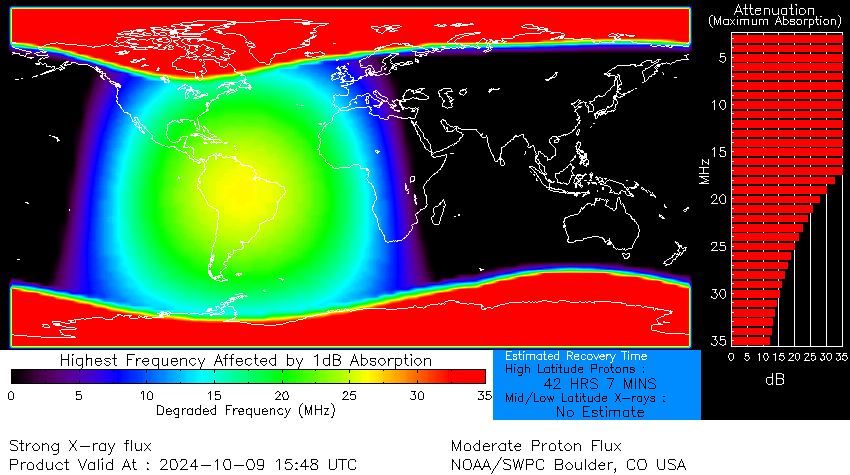UPDATED - Please scroll down
NOAA 3842 rotated over the southeast solar limb on 27 September, gradually growing in size and complexity. It developed an important magnetic delta structure in its leading spot as shown in the white light image and magnetogram underneath resp. left and right (SDO).
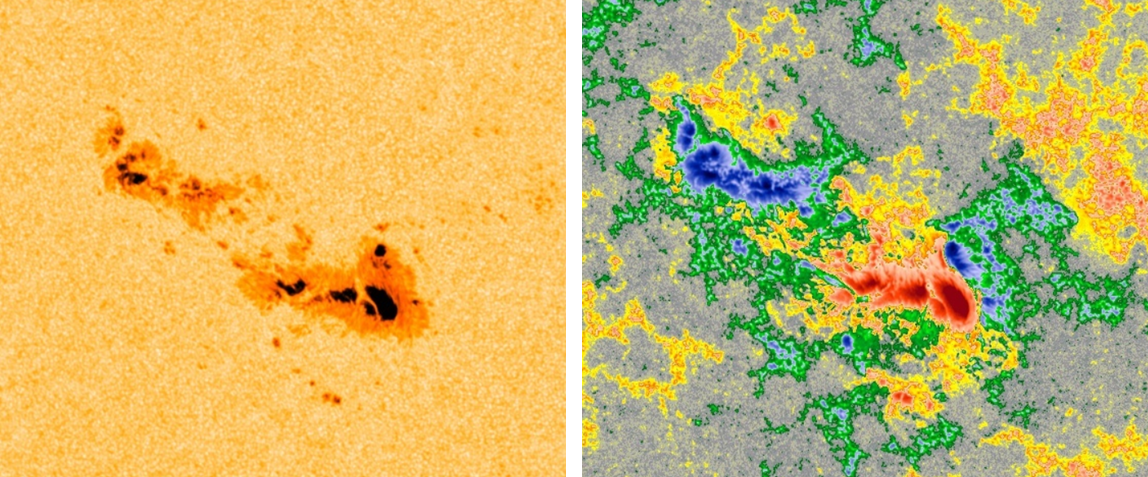
Following an M7 flare late on 30 September, this region produced an X7.1 flare on 1 October peaking at 22:20UTC (GOES). This is the second strongest flare so far this solar cycle (SC25). The extreme ultraviolet (EUV) imagery underneath to the right is from SDO/AIA 094 and shows the X7.1 flare near the time of its maximum. The blooming and diffraction patterns that can be seen in this image are instrumental (more information is in Note 1 of this STCE newsitem).
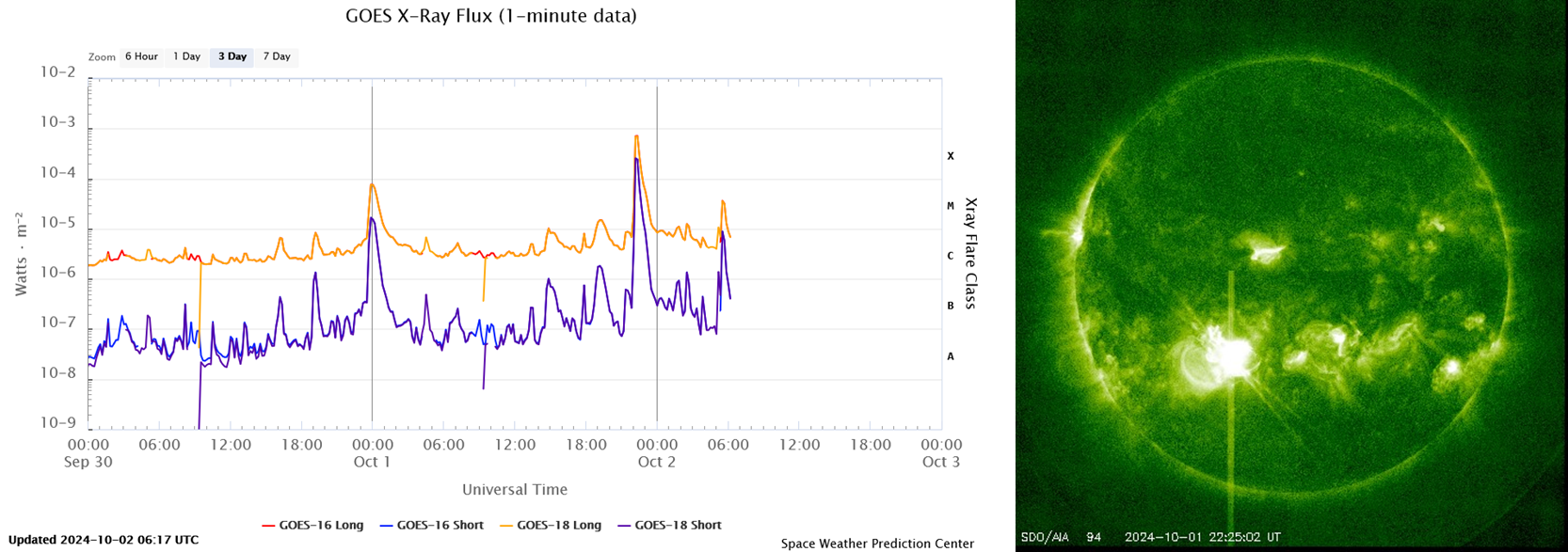
The greater than 10 MeV proton flux is still at background levels. The flaring event was also the source of a radio disturbance especially at all observed frequencies (NOAA/USAF network). Coronagraphic imagery by SOHO and STEREO-A show a CME directed to the southeast. In view of the location of the source region and the CME's width, it's virtually certain that this CME has an earth-directed component (see the SIDC website for further updates). Further strong flaring from NOAA 3842 over the next few days is very likely, with a chance on an earth-directed CME as well as an increasing chance on a proton event as the active region moves into the western solar hemisphere.
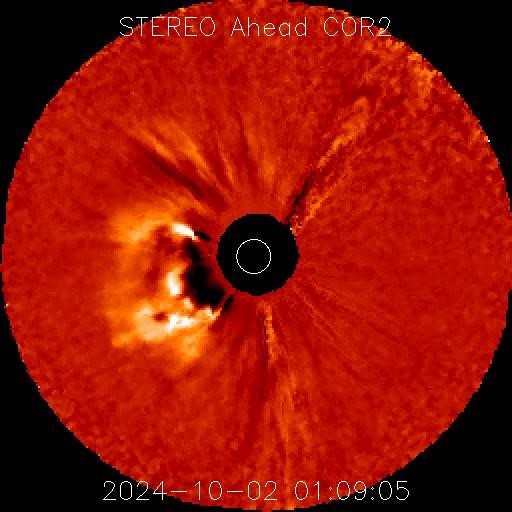
The X-class flare affected HF communications (3-30 MHz) mainly over the Pacific Ocean. This can be seen on the D-RAP map underneath (NOAA/SWPC). An advisory to civil aviation has been issued (PECASUS ).

UPDATES
UPDATE 3 October 2024 at 17:00UTC - NOAA 3842 has just produced the strongest flare of solar cycle 25 (SC25). The X9.0 flare peaked at 12:18UTC today 3 October (GOES ; JSON). This was already the second strong X-class flare in as many days by this sunspot group which still has a strong magnetic delta structure in its leading portion. The SDO/AIA 094 imagery underneath shows the eruption in extreme ultraviolet (EUV). The blooming and diffraction patterns that can be seen are instrumental (more information is in Note 1 of this STCE newsitem).
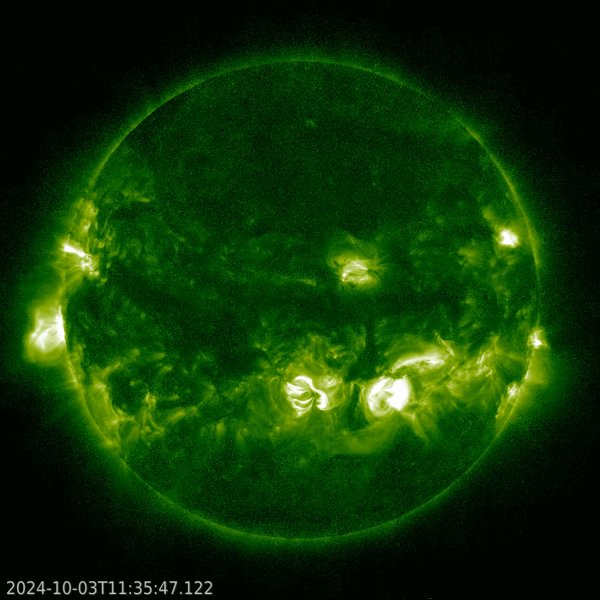
The greater than 10 MeV proton flux is still at background levels. The flaring event was also the source of a radio disturbance especially at all observed frequencies (NOAA/USAF network). It was especially strong at 410 MHz (160.000 sfu!) and also at 245 MHz (43.000 sfu), and also affected the 10.7cm radio flux. The radio astronomy station at Humain (HuRAS) recorded a Type II and Type IV radio burst, as shown in the radio spectrogram underneath.
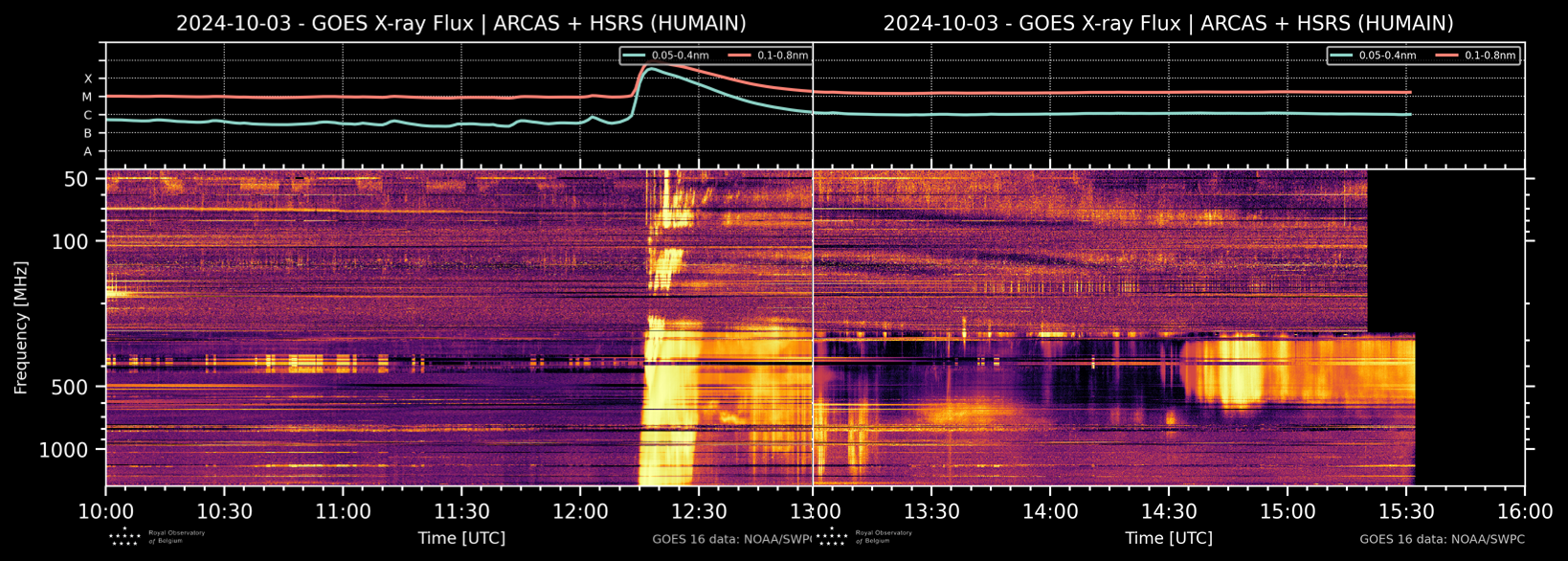
Coronagraphic imagery by SOHO and STEREO-A show a halo CME, and is directed to Earth, with an expected arrival on 5 or 6 October. Standing-by further analysis by the SIDC forecaster (see SIDC website for further updates). The imagery underneath combines EUV imagery from SDO with coronagraphic images from SOHO/LASCO C2. Further strong flaring from NOAA 3842 over the next few days is very likely, with a chance on an earth-directed CME as well as an increasing chance on a proton event as the active region advances further into the western solar hemisphere.
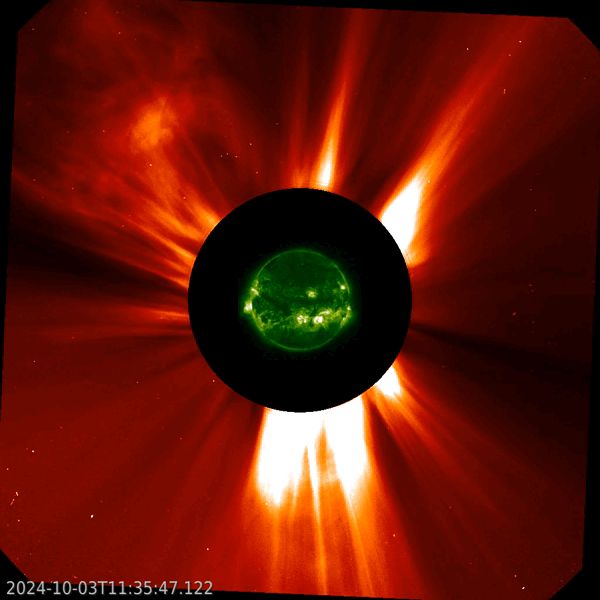
The X-class flare affected HF communications (3-30 MHz) over most of Africa, the mid- and south-Atlantic Ocean, and east Brazil. This can be seen on the D-RAP map underneath (NOAA/SWPC). An advisory to civil aviation has been issued (PECASUS). Associated with this flare, some magnetometer stations on the daylight side of the Earth such as on Tenerife (Spain), in Tamanrasset (Algeria) and on Tatuoca (Brazil) registered a strong solar flare effect (SFE) of 50-75 nT pending their location to the subsolar point (Intermagnet (BGS)). For comparison, the Carrington flare showed an SFE of 110 nT (Cliver & Svalgaard, 2004). An SFE happens when one or more components of the magnetic field strength shows a spike around the time of the flare's peak due to ionospheric enhancement by the flare's x-ray and (E)UV radiation (also known as a "magnetic crochet").

UPDATE 7 October 2024 at 21:45UTC - The series of CMEs related to the strong flaring activity from NOAA 3842 during 1-4 October produced a geomagnetic storm that started late on 6 October and reached moderate storm levels late on 7 October. (Kp=6o ; Potsdam). K_BEL remained at a modest minor storming, and the Dst index is only now at its most intense levels of about -91nT, gradually becoming more negative.
Meanwhile, NOAA 3842 produced its third X-class flare, this time an X2.1 peaking on 7 October at 19:13UTC. The image underneath was taken by GOES/SUVI 131 near the flare's maximum. An advisory to civil aviation for moderate HF Com disturbance (affecting mainly the East Pacific Ocean) has been issued (PECASUS). The greater than 10 MeV proton flux is -for the moment- still at background levels.
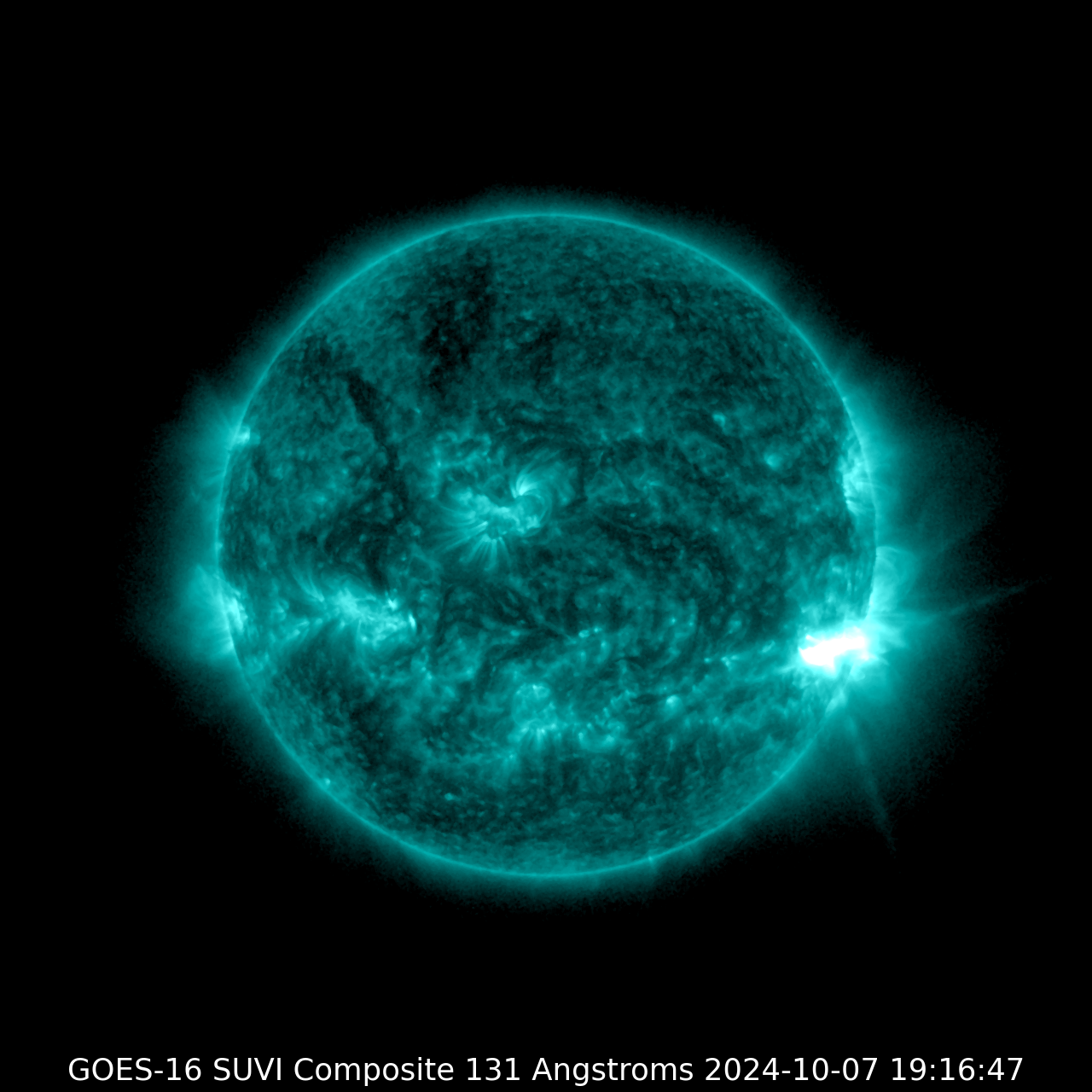
Only mild radio disturbances (<1000 pfu) were observed at all frequencies (NOAA/USAF network). The 10.7cm radio flux was affected by the radio emission (a so-called Tenflare), increasing 640 sfu over its background value and -at 20:00UTC- still 33 sfu above the pre-flare event level (277 sfu vs. 244 sfu ; Penticton). A distinct Type II burst was observed, as imaged by Owens Valley (see the radio sprectrogram underneath) indicative of a relatively slow CME, with a shock speed around 500 km/s. SOHO/LASCO/C2 showed a very solid CME to the south-west. Standing-by further coronagraphic imagery to determine the presence of an earth-directed component (SIDC forecaster). There remains a chance of another strong flare from NOAA 3842 in the coming days. However, as the active region approaches the west limb, the chances on an earth-directed component of any related CME will become smaller.
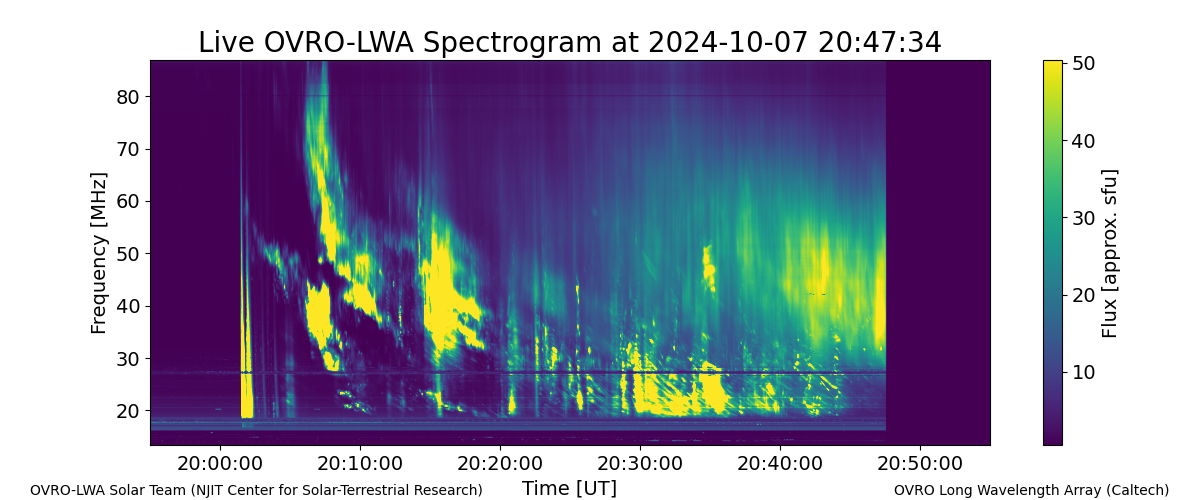
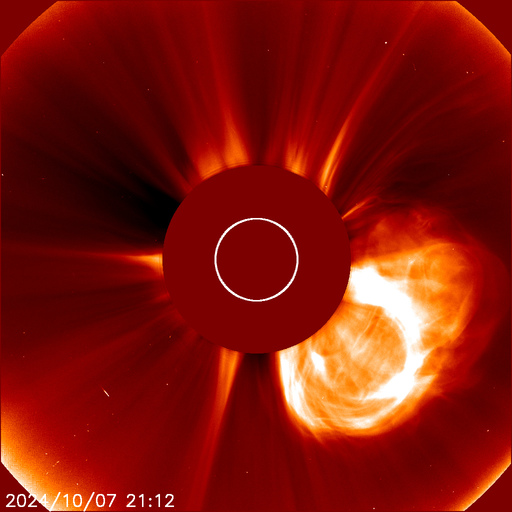
UPDATE 8 October 2024 at 10:30UTC - Following the X2 flare, the area surrounding NOAA 3842 got quite destabilized resulting in an X1.0 flare over active region NOAA 3844 peaking at 21:02UTC, and a filament eruption to the southeast of NOAA 3842 taking place between 03:00 and 06:00UTC on 08 October. SDO/AIA images underneath show all this activity 07/17:00UTC - 08/07:00UTC) at low temperatures (AIA 304; left) and high temperatures (AIA 131; right). The greater than 10 MeV proton flux mildly increased, reaching a maximum 2.5 pfu at 04:45UTC on 8 October. The alert threshold of 10 pfu was not reached.
 |
 |
All this activity resulted into 2 CMEs. The first one is related to the X2-X1 flaring with ejected material most likely related to the timing of the observed Type II (see above; OVSE) and mostly over NOAA 3844, according to the location of the post-eruption coronal loops in the imagery above. The associated asymmetric halo CME clearly has an earth-directed component (SOHO/LASCO C3 images underneath). The feature in the right of the field of view is comet Tsuchinshan–ATLAS that will become visible in the evening sky of the Earth's northern hemisphere. The second CME was associated with the filament eruption and became visible in SOHO/LASCO C3 imagery starting at 06:06UTC. This CME is smaller than the first one, but the source is also closer to the solar disk centre. The analysis of any earth-directed component is in progress (SIDC forecaster).
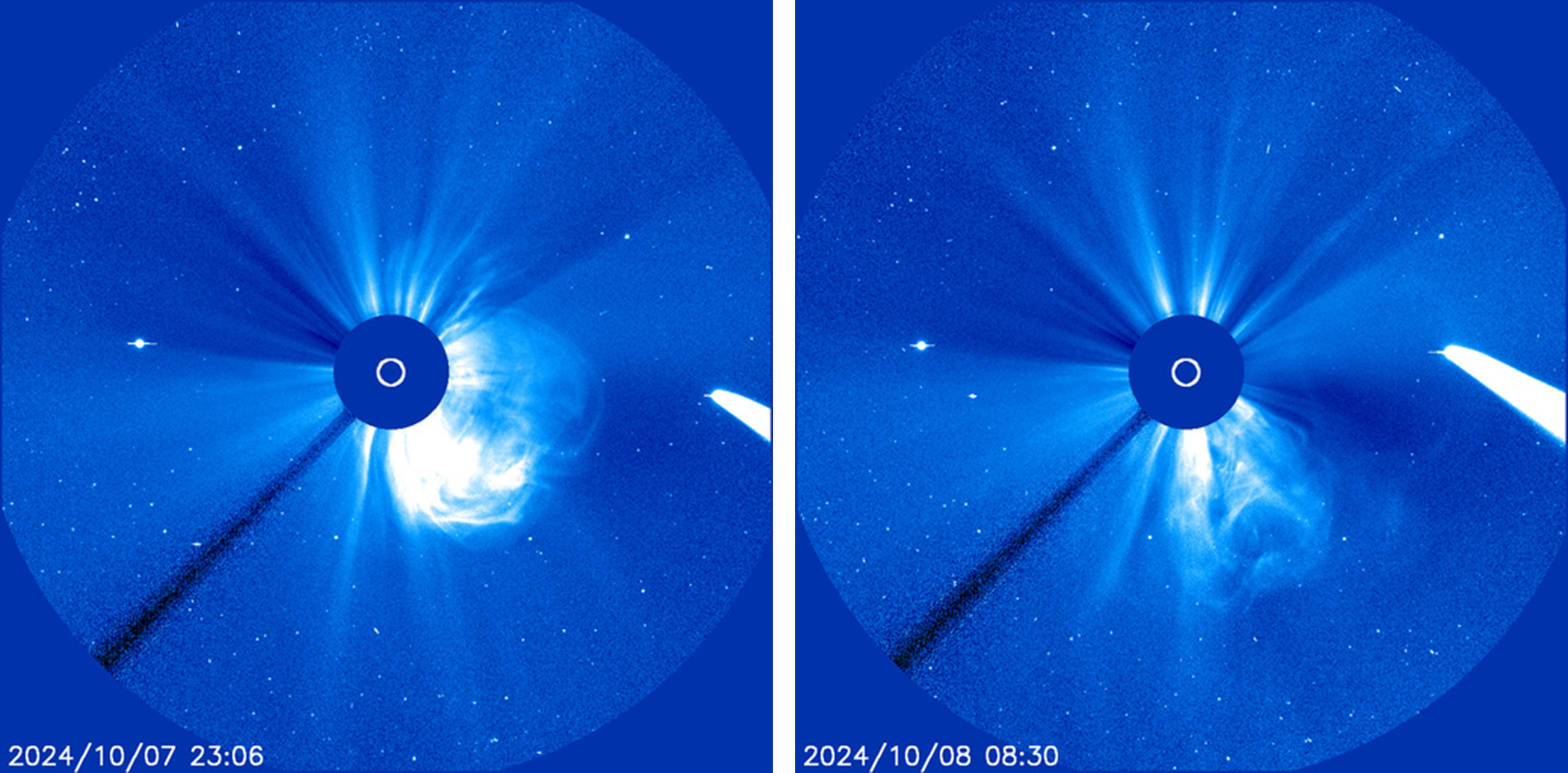
Meanwhile, the earth environment continues to be hammered by a series of interplanetary CMEs launched by solar activity between 1 and 4 October. DSCOVR and ACE solar wind data show the arrival of 3 to possibly 4 ICMEs, each having a progressively stronger Bz (vertical component of the interplanetary magnetic field ; map). BZ was around -16nT from about 01:30UTC to 04:30UTC on 8 October. This resulted in a strong (major) geomagnetic storm with NOAA's estimated Kp reaching 7+ and the Potsdam Kp 7o (see map underneath). K_BEL remained at a modest minor storming, and the provisional Dst index reached its most negative value (-153 nT) during the 07-08 UTC interval.
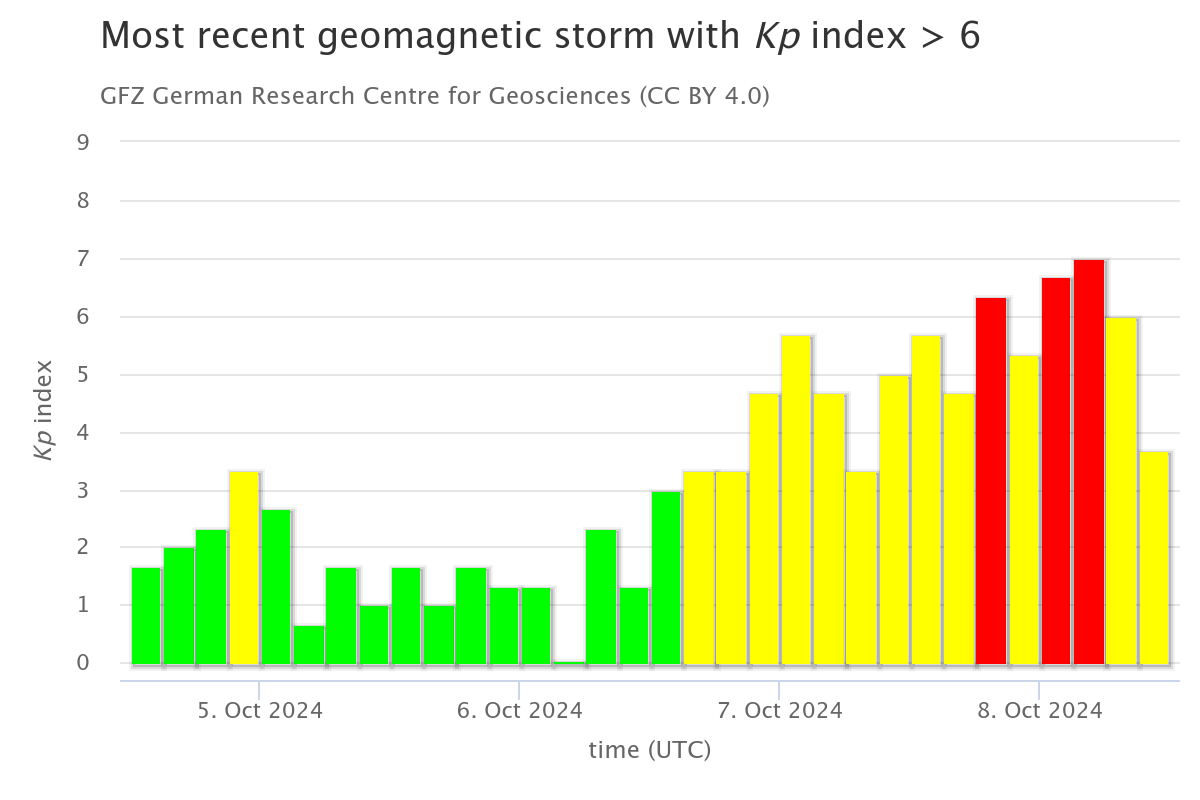
UPDATE 9 October 2024 at 17:45UTC - NOAA 3842 has produced yet another X-class flare. The impulsive X1.4 event peaked on 9 October at 15:47UTC. H-alpha imagery places the source near the trailing portion of NOAA 3842 (GONG ; image). The GOES/SUVI 131 image underneath shows the eruption in extreme ultraviolet (EUV). The blooming and diffraction patterns that can be seen are instrumental (more information is in Note 1 of this STCE newsitem).
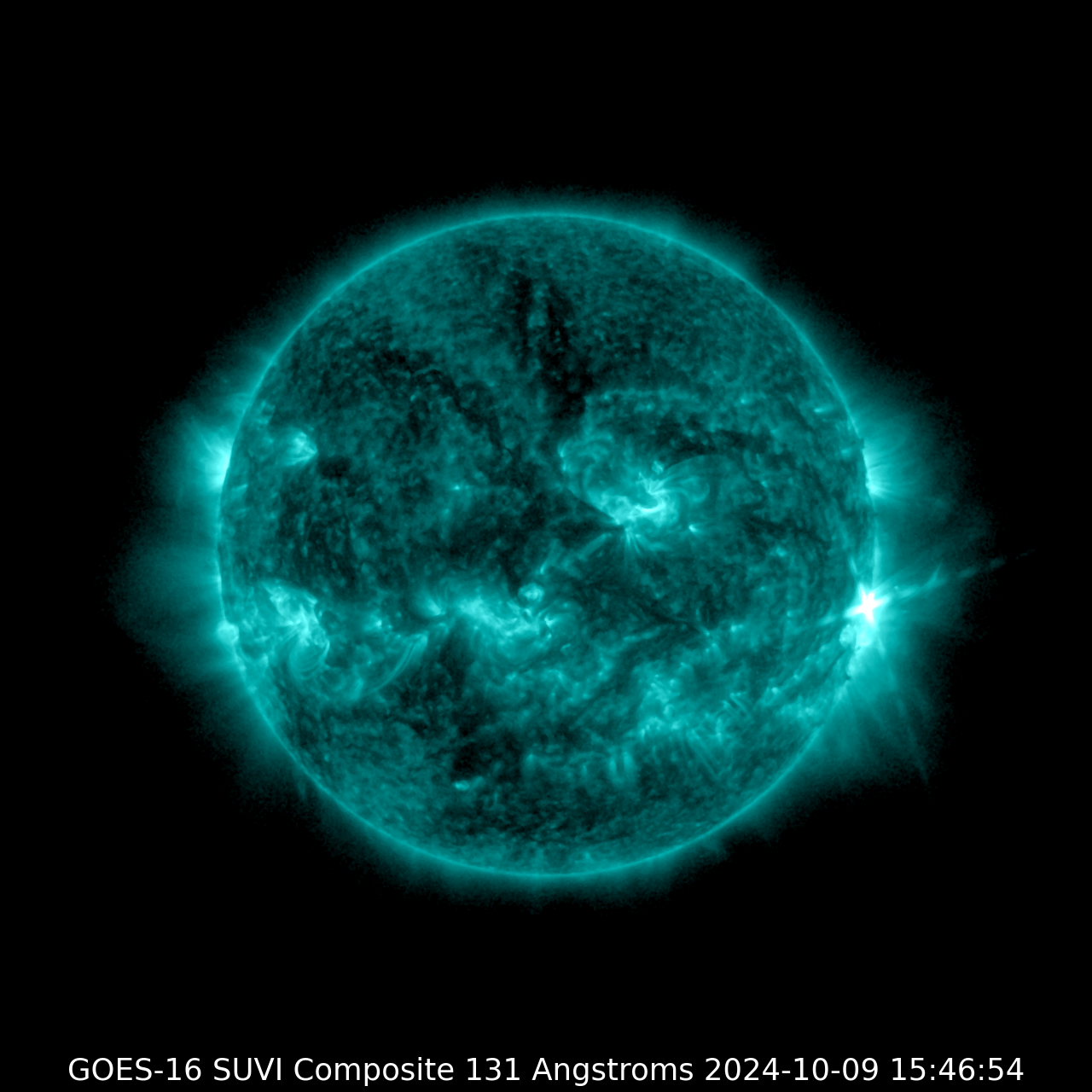
The greater than 10 MeV proton flux is still near 1000 pfu following the X1.8 flare earlier this morning (see this STCE newsflash). This new X-class flare may still add to the proton flux levels. The flaring event was also the source of a relatively mild radio disturbance at all observed frequencies (NOAA/USAF network), and especially affected GNSS frequencies (18.000 sfu at 1415 MHz). Also the 10.7cm radio flux was affected (2300 sfu) by the flare, and may still be so during the 19:30-20-30UTC observation run by Penticton for "the" daily solar radio flux. Despite that the flare timing was close to sunset for Belgium, the radio astronomy station at Humain (HuRAS) was still able to record a Type III and Type II radio burst, as shown in the radio spectrogram underneath.
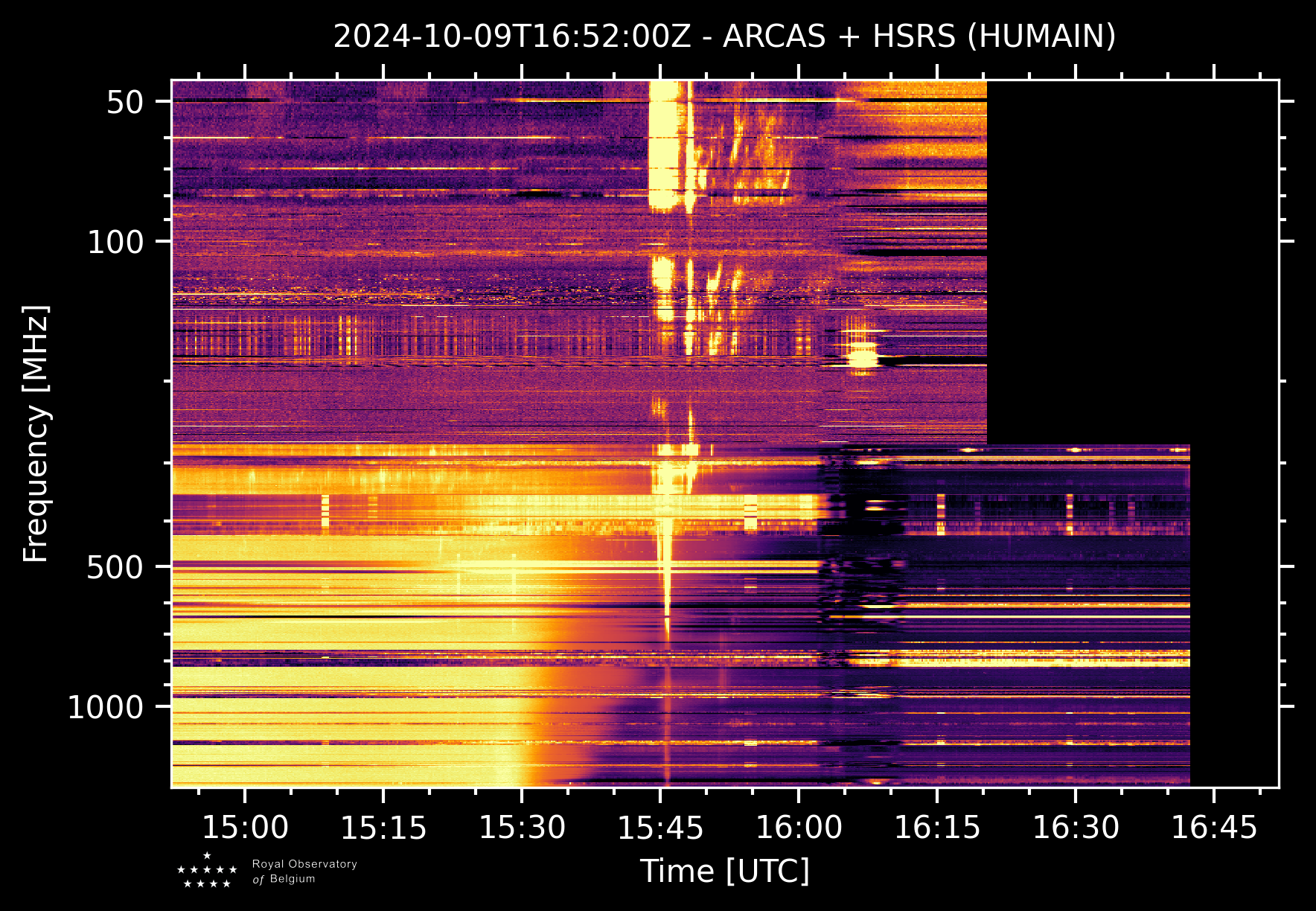
A single coronagraphic image by SOHO / LASCO C2 from 16:12UTC shows a rather small CME moving to the northwest. Standing-by further coronagraphic imagery and the analysis by the SIDC forecaster (see SIDC website for further updates). Chances on further strong flaring by NOAA 3842 are decreasing as the region moves further over the west limb in the coming days.

The X-class flare mildly affected HF communications (3-30 MHz) over mainly South-America. This can be seen on the D-RAP map underneath (NOAA/SWPC). An advisory to civil aviation has been issued (CRC, PECASUS). The main and ongoing HF Com disturbance is from the ongoing proton event associated with the X-class flare from earlier this morning and is affecting the polar regions (Polar Cap Absorption).
